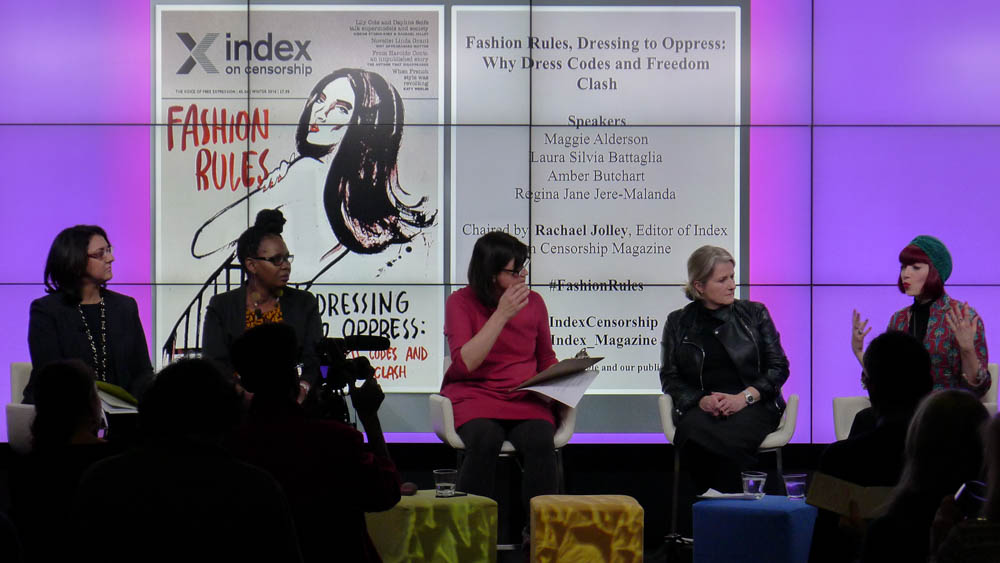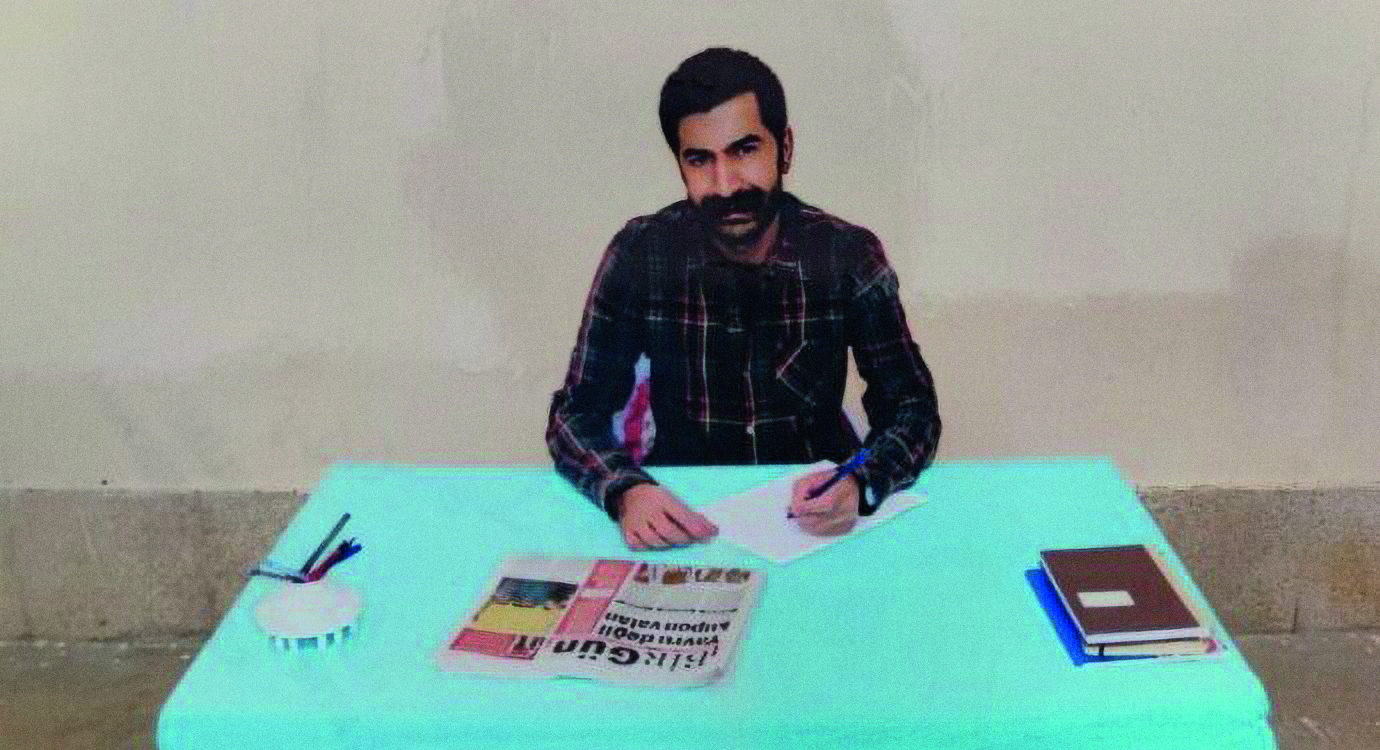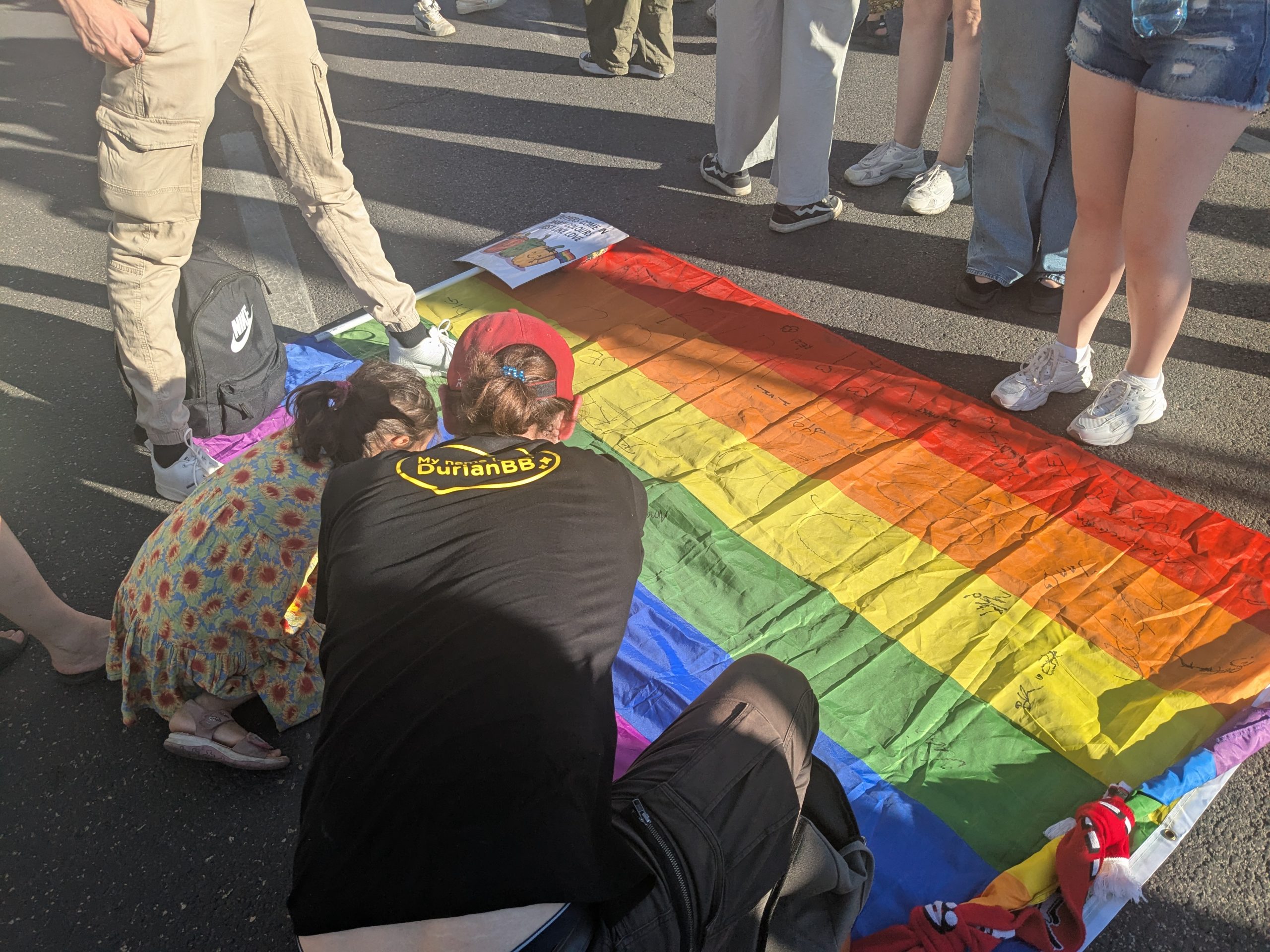[vc_row][vc_column][vc_custom_heading text=”It may be easy to dismiss fashion as a trivial issue, but an expert panel argued otherwise at the launch of the winter 2016 Index on Censorship magazine’s new issue.” font_container=”tag:p|font_size:24|text_align:left” google_fonts=”font_family:Libre%20Baskerville%3Aregular%2Citalic%2C700|font_style:400%20italic%3A400%3Aitalic”][vc_video link=”https://www.youtube.com/playlist?list=PLlUhPA3TuB56uIAdpLWxk_kqBzjVOV9_J” title=”#FashionRules at Google”][/vc_column][/vc_row][vc_row][vc_column][vc_column_text]
“I wasn’t trying to rebel,” former Elle magazine editor Maggie Alderson told the room at the launch of Index on Censorship’s winter 2016 issue Fashion Rules: Dressing to Oppress, which was hosted by Google at its central London offices. “I was just expressing myself.”
Maggie Alderson was speaking about how she was arrested in London as a teenager for wearing a t-shirt featuring two naked cowboys, and she lamented what she sees as a lack of creativity in modern western fashion, longing for the days when she would be frequently shocked and even appalled by designers such as Alexander McQueen.
Alderson was joined by fellow panelists — fashion historian Amber Butchart, New African Woman magazine editor Regina Jane Jere-Malanda, and award-winning journalist Laura Silvia Battaglia — for a wide-ranging discussion chaired by Index magazine editor Rachael Jolley to explore the nexus between fashion and freedom of expression.
Battaglia explained the literal interpretation of the Koran that requires women to cover their faces with “a towel”, and told of a teenage girl in Saudi Arabia who received death threats after posting a selfie without her compulsory abaya, but pointed out that those same sects of Islam also require men to dress a certain way.
Regina Jane Jere-Malanda did not hesitate to call out the misogyny of attitudes to women’s clothing in African countries, telling of how an MP in her home country of Zambia was thrown of Parliament for wearing a skirt that was too short, while Amber Butchart said that people have never liked being ordered to conform, explaining how American sailors used to sew intricate patterns into the inside of their uniforms to express themselves while on shore leave, and mentioning that Tartan became a symbol of Scottish rebellion simply because it was banned by the English.
Audience questions raised new topics such as the politics surrounding black women wearing natural hairstyles, and the taboo on men wearing women’s clothing.
.@MaggieA: “I just thought it was a fantastic t-shirt, a beautiful drawing, but I ended up getting arrested for wearing it.” #FashionRules pic.twitter.com/9Bhrmcr6Wc
— Index on Censorship (@IndexCensorship) January 18, 2017
“Governments ban clothing when they’re feeling insecure. One purpose is to uphold rigid social demarcation.” – @amberbutchart#FashionRules
— I.G. Advisors (@IG_Advisors) January 18, 2017
.@AmberButchart: “One of my favourite forms of rebellion is against enforced uniformity. We don’t like to be told to conform.” #FashionRules
— Index on Censorship (@IndexCensorship) January 18, 2017
.@MaggieA: “Fashion magazines today are little more than shopping lists. I don’t see any evidence of creativity.” #FashionRules
— Index on Censorship (@IndexCensorship) January 18, 2017
Fascinating discussion on #fashionrules and Dressing to Oppress @IndexCensorship: culture, religion, rebellion pic.twitter.com/GHsItsnKbN
— Ria Hawthorn (@riahawthorn) January 18, 2017
.@GinaJaneJere asks “who dictates what we wear?” @IndexCensorship @Index_Magazine #FashionRules pic.twitter.com/WMyglCj7IR
— Not My Style (@notmystyleuk) January 18, 2017
Loved attending this evening’s #FashionRules @Index_Magazine launch on behalf of @notmystyleuk – great topics discussed! @IndexCensorship pic.twitter.com/mfCKkty6di
— Hannah Donald (@hannahdonald20) January 18, 2017
Listen to the #FashionRules playlist.
Thank you to Google for hosting #FashionRules, as well as our publishers SAGE for helping to make the event happen.[/vc_column_text][vc_column_text]You can order your copy of the latest issue here, or take out a digital subscription via Exact Editions. Copies are also available at the BFI, the Serpentine Gallery, MagCulture, (London), News from Nowhere (Liverpool), Home (Manchester), Calton Books (Glasgow) and on Amazon. Each magazine sale helps Index on Censorship continue its fight for free expression worldwide.[/vc_column_text][vc_single_image image=”84974″ img_size=”full” add_caption=”yes” alignment=”center”][vc_media_grid element_width=”3″ grid_id=”vc_gid:1484923141783-3032303e-c962-0″ include=”84955,84957,84958,84959,84960,84961,84962,84963,84965,84966,84967,84968,84969,84970,84971,84972,84973,84974,84975″][/vc_column][/vc_row][vc_row content_placement=”top”][vc_column width=”1/3″][vc_custom_heading text=”Fashion Rules” font_container=”tag:p|font_size:24|text_align:left” link=”url:https%3A%2F%2Fwww.indexoncensorship.org%2F2016%2F12%2Ffashion-rules%2F|||”][vc_column_text]The winter 2016 issue of Index on Censorship magazine looks at fashion and how people both express freedom through what they wear.
In the issue: interviews with Lily Cole, Paulo Scott and Daphne Selfe, articles by novelists Linda Grant and Maggie Alderson plus Eliza Vitri Handayani on why punks are persecuted in Indonesia. Special report on clothes and freedom, how Shakespeare challenges the censors, and assessing Correa’s free speech heritage.[/vc_column_text][/vc_column][vc_column width=”1/3″][vc_single_image image=”82377″ img_size=”medium” alignment=”center” onclick=”custom_link” link=”https://www.indexoncensorship.org/2016/12/fashion-rules/”][/vc_column][vc_column width=”1/3″ css=”.vc_custom_1481888488328{padding-bottom: 50px !important;}”][vc_custom_heading text=”Subscribe” font_container=”tag:p|font_size:24|text_align:left” link=”url:https%3A%2F%2Fwww.indexoncensorship.org%2Fsubscribe%2F|||”][vc_column_text]In print, online. In your mailbox, on your iPad.
Subscription options from £18.
Every subscriber helps support Index on Censorship’s projects around the world.
![]() SUBSCRIBE NOW[/vc_column_text][/vc_column][/vc_row]
SUBSCRIBE NOW[/vc_column_text][/vc_column][/vc_row]





